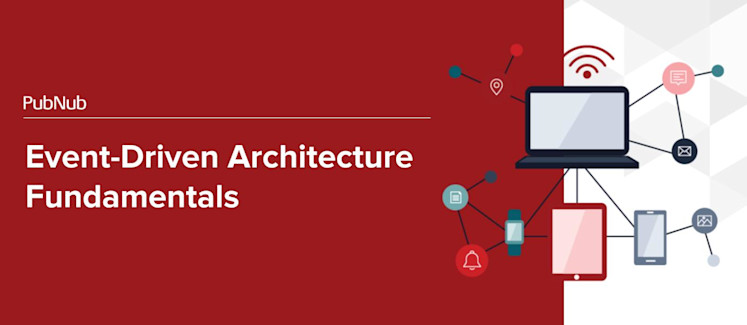
Delivering a true real-time digital experience is a must-have for modern app users. But with expectations around minimizing downtime and managing real-time “events” such as IoT device control, pricing/shipping updates, geolocation, and more, it can be challenging for organizations to avoid common pitfalls when building these event-driven systems.
Event-driven architecture (EDA) is a design pattern with loosely coupled components used to trigger and communicate events. It has become widely used in technology where real-time interactions are taking place because its benefits include:
Reduced latency
Effortless scaling
Reliable operational efficiency
Read on to gain a better understanding of the EDA landscape and get insight into how developers can leverage this architecture for deploying and scaling their event-driven applications.
What is event-driven architecture?
Event-driven architecture (EDA) is a software design pattern used in microservices or other decoupled services or apps. Each service in the ecosystem can asynchronously publish and subscribe to events via an event broker.
An event is any change in state or update within the ecosystem. Examples of events include customer requests, inventory updates, sensor readings, etc. The event broker acts as a middleman allowing a “loose coupling” between applications to transport events to and from event consumers.
NOTE: An event is distinct from a message. A message is data transmitted to a specific address, whereas an event is data broadcasted as it happens and can be consumed by any service listening for it.
EDA provides a flexible, scalable, and real-time approach to processing actions and responses quickly. It is ideal for managing high volumes and high-velocity data in real time with a minimum time lag. It can handle complex event processing, such as pattern matching or aggregation over time windows.
Event-driven architecture vs. Traditional architecture
Traditional Architecture
Traditional architecture follows a request-response pattern where a server transmits a query and waits for a response. This is great when working with static data but not convenient for real-timee processing where data changes.
Some key characteristics of traditional architecture:
The service should be online when pull requests are made, or the request will go unfulfilled.
Making changes to the system is complicated and time-consuming.
Any data changes erase previous information about state changes.
It is unable to record changes from multiple sources simultaneously.
It supports synchronized communication and recording of events, ensuring the information is consistent.
Event-Driven Architecture (EDA)
EDA functions in real time, so all event consumers subscribed to events receive them as produced by the producers.
Some key characteristics of EDA:
The system does not need to know consumers are online for events to be published.
Changes can be made to a specific component without impacting the entire process flow.
The system records and retains the history of every event.
EDA can record data while executing processes, allowing continuous intelligence in a computer system.
EDA does not follow a chronological alignment of timelines, making it difficult to synchronize information.
Event-driven architecture use cases
Multi-User Collaboration
Event-driven architecture can detect the online connectivity of a user or a device and update the system's state accordingly. Using EDA, multiple users can interact simultaneously in digital workspaces, virtual classrooms, or team collaboration settings. Some example scenarios include triggering actions like push notifications for when users are online and gathering and sending real-time data such as quiz results and populating that to a leaderboard.
Marketplaces & Auctions
Event-driven architecture gives marketplaces & auction organizations the freedom to enlist different vendors for different services like order validation, stock management, and payment processing. Services produce and consume data for new events, which are then sent to an event broker. The event broker pushes each new event to the relevant services automatically.
Because it uses decoupled applications, event-driven architecture also gives organizations the flexibility to introduce changes to the system. For example, if the organization introduces new suppliers or distributors, only that specific process will be changed. The remaining operation will continue functioning, causing minimal or no interruption to the overall customer experience.
IoT Device Control
Event-driven architecture can manage and process data from multiple sources in real time, making it an ideal system for running IoT devices. It can publish, receive, and process a wide range of IoT commands simultaneously, which allows the system to trigger the appropriate response promptly without repeatedly asking for information through polls.
For example, if a sensor picks up a change in the state (like a change in temperature, location, or volume), the system can trigger the appropriate response. In this case, it would be notifying the appropriate personnel. Moreover, developers can modify existing code and introduce new processes without impacting the currently running processes.
Logistics and Transportation
Event-driven architecture is ideal for tracking shipments, monitoring inventory, and providing real-time customer and logistics company updates. The logistics industry manages many individual devices across a wide region. With EDA, developers can build an event mesh across all the services and platforms, allowing better synchronization between different parts of the organization to serve and collect data across multiple web and mobile apps.
Also, as the amount of data invariably increases, the organization can scale without losing previous information or disrupting the current workflows using a more agile approach to development.
Do you want to learn more, including how to implement EDA? Download the full white paper.
Alternatively, you can contact our sales team or start your free trial to experience how PubNub enables real-time interactions.

